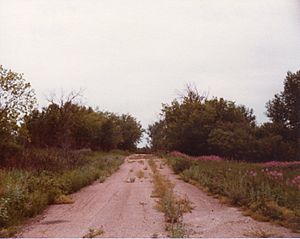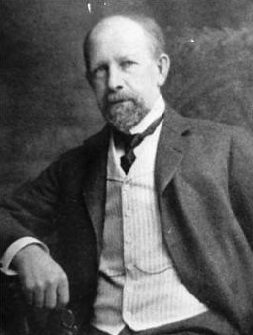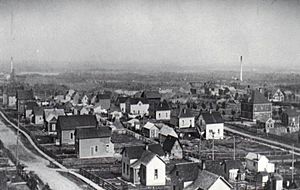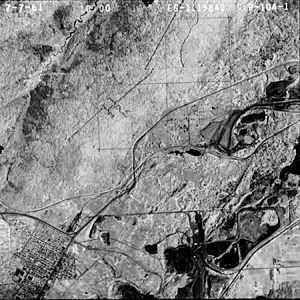Elcor, Minnesota facts for kids
Quick facts for kids
Elcor
|
|
|---|---|

Maritana Avenue, one of only two paved roads in Elcor, looking south toward Manilla Street, 1980
|
|
| Country | United States |
| State | Minnesota |
| County | St. Louis |
| Elevation | 1,542 ft (470 m) |
| Time zone | UTC-6 (Central (CST)) |
| • Summer (DST) | UTC-5 (CDT) |
| Area code(s) | 218 |
| GNIS feature ID | 661197 |
Elcor was a ghost town in Minnesota, USA. It was a lively place from 1897 to 1956, but now it's completely gone. It was built on the Mesabi Iron Range in St. Louis County, close to the city of Gilbert. Even though it was near Gilbert, Elcor was its own community and not just a neighborhood of Gilbert. The people of Elcor were generally counted as citizens of Gilbert. Later, after 1969, the land where Elcor once stood became part of Gilbert.
In 1890, the Merritt brothers found iron ore near Mountain Iron. This discovery started a huge rush for iron on the Mesabi Range. The Elba mine opened in 1897, and the town was planned by Don H. Bacon, who was the president of the Minnesota Iron Company. Another mine nearby, the Corsica, opened in 1901. The community was first called "Elba" after the first mine. The name "Elcor" was created later by combining parts of both mine names: "El" from Elba and "Cor" from Corsica.
After the United States Steel Corporation was formed, Pickands Mather and Company leased both the Elba and Corsica mines. Many people from different countries moved to Elcor, making it a mix of cultures, much like the USA at that time. Around 1920, when Elcor was at its busiest, it had almost 1,000 residents. It also had two churches, a post office, a general store, a school, a train station, and its own police.
Elcor was a "mining location," meaning the mining company built the town to house its workers. People could own their homes, but the land belonged to the mining company. When the Corsica mine closed in 1954, Pickands Mather and Company told everyone to leave. They wanted to reclaim the land. By 1956, Elcor was completely empty. The land changed owners many times. In 1993, the Inland Steel Company started piling up overburden (waste rock) from what is now the Minorca Mine right where Elcor used to be.
Contents
History of Elcor
Elcor's story began in 1897 with the Elba mine and ended in 1954 when the Corsica mine closed. Elcor was first known as the Elba location. It was situated between the towns of McKinley and Gilbert. Elcor was one of about 50 mining locations in the area. These were towns built by mining companies for their workers. Some, like Sparta, still exist. Others, like Elcor, have disappeared.
How Elcor Started
The community was first named "Elba" after the first underground mine. A few years later, the Corsica mine opened. The Elba mine started in 1897. With it, the "Elba location" was born.
The Minnesota Iron Company developed the Elba mine. They shipped the first ore in 1898. The Corsica mine, owned by Petit and Robinson, shipped its first ore in 1901. Don H. Bacon, who became president of the Minnesota Iron Company, loved to travel. He named many mines after Mediterranean islands, like Malta, Maiorica, Corsica, and Elba. He also liked names starting with "M."
Because of Don H. Bacon's love for the letter "M," all the streets in Elcor began with "M":
- Mohawk Street
- Malta Street
- Manilla Street (this was the main street)
- Manola Street
- Mariposa Avenue
- Mauna Loa Avenue
- Maritana Avenue
- Minorca Avenue
Manilla Street was the first street in "Elba." Company houses were built on both sides of it.
The Elba mine was operated by the Minnesota Iron Company until 1900. After the United States Steel Corporation was formed, Pickands Mather and Company leased both the Elba and Corsica mines. They operated both mines for many years. William Philip Chinn became the superintendent of the Elba and Corsica mines under the new management.
The town grew quickly in the early 1900s. In 1902, the Corsica mine became very busy, and many houses were built. The community thrived on iron mining. After World War I, its population reached almost 1,000 people. Elcor became a neat town with over 100 houses.
Life in Elcor
The people of Elcor were tough pioneers from many different countries. These included Croatians, Slovenians, Finns, Italians, Germans, Scandinavians, and English people from Cornwall. They all respected each other and communicated well despite their different backgrounds.
In the early days, houses were made of wood. They had 4-board high fences and boardwalks in front. Most streets were just dirt roads. Winters were very cold. Horses with V-shaped plows cleared the streets. In the center of town was a community pump. People got water from the mine twice a day at certain times. Everyone had to carry water home in buckets, tubs, and barrels for their daily needs. There was no shut-off valve. Later, water came from a deep well after a water tower was built. St. Bernard dogs even helped carry water to homes.
Running water and bathtubs came much later, around 1915 or 1916. Ditches were dug to bring water from Gilbert. Before 1916, Kerosene lamps were used for light. Then, power lines were installed. The only telephone at first was at the Elba mine office.
The Finns in Elcor created a temperance society. Together, they built the Finnish Temperance Hall. The community also had a band, a volunteer fire department, tennis courts, and a clubhouse for employees. A small Methodist Church and Presbyterian Church were built. The town had a night watchman and later a full-time patrolman. There was never any crime or trouble in Elcor.
One of the houses was used as the first school in Elcor. Soon, a new school was built. Elcor was part of the Gilbert School system. There were five school houses in the district. The McKinley-Elba school was built in 1900. It was halfway between McKinley and Elba. It had four teachers and taught students up to 8th grade from both communities. Students walked to school on boardwalks. There was also a primary school in Elcor on Malta Street.
To rent a home in Elcor, you had to agree to take in boarders. A "cottage" cost $7.50 per month. This later included electricity. When water was piped in from Gilbert, homes were charged an extra $1.00 per month. People were later allowed to own their homes, but the mining company still owned the land. Rent did not increase until the homes were moved in 1955.
Families had their own gardens. They grew many vegetables that lasted through the long winter. Neighbors shared what they had. Some families raised cows, pigs, and chickens. Others had horses to carry firewood. There was little refrigeration back then, so keeping food fresh was hard. Before the store came to Elcor, people went to stores in McKinley or Gilbert. Deliveries were made daily, and orders were taken for the next day. Families would charge their purchases and pay once a month on payday.
The Finnish Hall became the Elcor Mercantile and a U.S. Post Office in 1920. The town greatly appreciated having a local store and post office. When the post office opened, there was confusion with mail because another town in Minnesota was also named "Elba." The name "Corsica" was also tried, but it caused the same problem. Finally, the name "Elcor" was created from parts of both mine names. The name "Elcor" was even painted in large white letters on the town's water tower.
Mail was picked up twice daily from the Duluth and Iron Range (later Duluth, Missabe and Iron Range) railroad tracks south of the store. Later, the Elcor Mercantile started selling Conoco gasoline, kerosene, fuel oils, motor oils, and even outboard motors. Sidewalks of cement were built along the streets. Bright red fire hydrants were installed. Homes were insulated, and people started buying refrigerators. Manilla Street and Maritana Avenue were paved. Greyhound Bus Lines made a stop at the Elcor Mercantile. Elcor had a baseball team and an ice-hockey team, the "Elcor-Conoco's," which was one of the best on the Iron Range. Blackhawks goaltender Sam LoPresti was from Elcor.
The Corsica and Elba mines were the main places to work until 1926. That's when the underground Elba mine closed because all its ore was gone. A few years later, the Corsica mine became an open pit mine. This made the town feel safe again. But then the Great Depression hit. In 1929, Corsica closed and stayed closed for many years. Only a few paid workers remained. The Corsica mine was empty until 1940. When World War II began, mining became busy again.
Why Elcor Was Abandoned
In 1954, the Corsica mine finally shut down. Workers were told it was "temporary" because there was less demand for that type of ore. The mine pit was allowed to fill with water. Pickands Mather said "temporary" might mean a long time, but maybe the mine would reopen. Mining stopped. A year later, Pickands Mather and Company, who managed the mines and the land, ordered residents to leave. The remaining families had to move out so the company could reclaim the land.
People had different ideas about why the order was given. Some thought the company wanted the land for a dump. Others believed the company didn't want to maintain the town anymore. Still others thought it was no longer profitable for the company to own houses. No one in charge would say what would happen to the land.
Residents who rented company-owned houses could buy them cheaply if they moved them out of town. For many, moving their homes used up a lot of their savings. They left behind only empty foundations. Most Elcor residents bought land in nearby Gilbert or McKinley. Land prices went up very quickly when it was clear Elcor would be gone. Lots that cost $75.00 were suddenly selling for $500.00. The last parts of the old mining town were removed in 1956. Every single building was torn down or moved. For some years, only old foundations, sidewalks, rusting stoves, pipes, bottles, and yard plants remained. These could be seen from the old section of Minnesota State Highway 135. A rusted fire hydrant and a porcelain toilet bowl were also left behind. An old rail line went through the townsite. Mine shafts were boarded up. After everyone left, the company dumped huge piles of iron ore on the roads leading into Elcor, turning a busy community into a ghost town.
For a while, the only thing left at the old mining site was a 200-foot smokestack. It stood alone near the Corsica mine. This unique stack was built by Cornish miners in 1901. It was the last of its kind on the Mesabi Iron Range. The Iron Range Historical Society wanted to save it because it was strong and historically important. However, the stack was already set to be destroyed as part of a state cleanup program. Many people worried it might fall and hurt someone. Others thought it was a danger to airplanes. In 1976, the stack was destroyed. It took three tries and almost 100 pounds of dynamite to bring it down.
After the smokestack was gone, the land where Elcor stood changed owners several times. It eventually became part of the Laurentian mine, which is now owned by ArcelorMittal. This mine has been renamed the Minorca mine, possibly as a nod to Elcor's past. The Minorca mine is now located where Elcor used to be.
Geology of the Area
Elcor was built on a type of rock called taconite. This rock is about 30% iron and has areas of very rich ore. It is part of the Biwabik iron formation. This iron-rich rock was formed during the Precambrian era at the bottom of a large body of water called the Animikie Sea. This iron-bearing rock stretches under Lake Superior. It goes from the Mesabi and Vermilion Iron Range in the north, down to the Gogebic Iron Range in Wisconsin and Michigan, and west to the Cuyuna Iron Range. The iron ore in Michigan was different from the soft brown hematite found on the Mesabi Range. There is also iron in other parts of Minnesota, but not enough to mine easily anymore.
Geologists divide the iron-bearing rocks of the eastern Mesabi Iron Range into several layers. The four main layers, from top to bottom, are called the Upper Slaty, Upper Cherty, Lower Slaty, and Lower Cherty. Below these layers are quartzite and granite. On top are Virginia Slate and Duluth Gabbro. The Slate layer is from 50 to several hundred feet thick. The four iron-bearing layers below it are from 400 to 600 feet thick.
Geography and Climate
Elcor was located in the Laurentian Mixed Forest Province in the Arrowhead region of northern Minnesota. The weather in this part of the state is mostly controlled by polar air masses all year. The area gets about 21 to 32 inches (53 to 81 cm) of rain and snow each year. The average yearly temperature is about 34 °F (1 °C) in the northern part of the forest and 40 °F (4 °C) in the southern part.
July is the warmest month. The average high temperature is 78 °F (26 °C), and the average low is 51 °F (11 °C). January is the coldest month. The average high temperature is 18 °F (-8 °C), and the average low temperature is -5 °F (-21 °C). Elcor was about 22 miles (35 km) south-southwest of Tower, Minnesota. Tower holds the record for the lowest temperature in Minnesota, which was -60 °F (-51 °C) on February 2, 1996.
Images for kids









